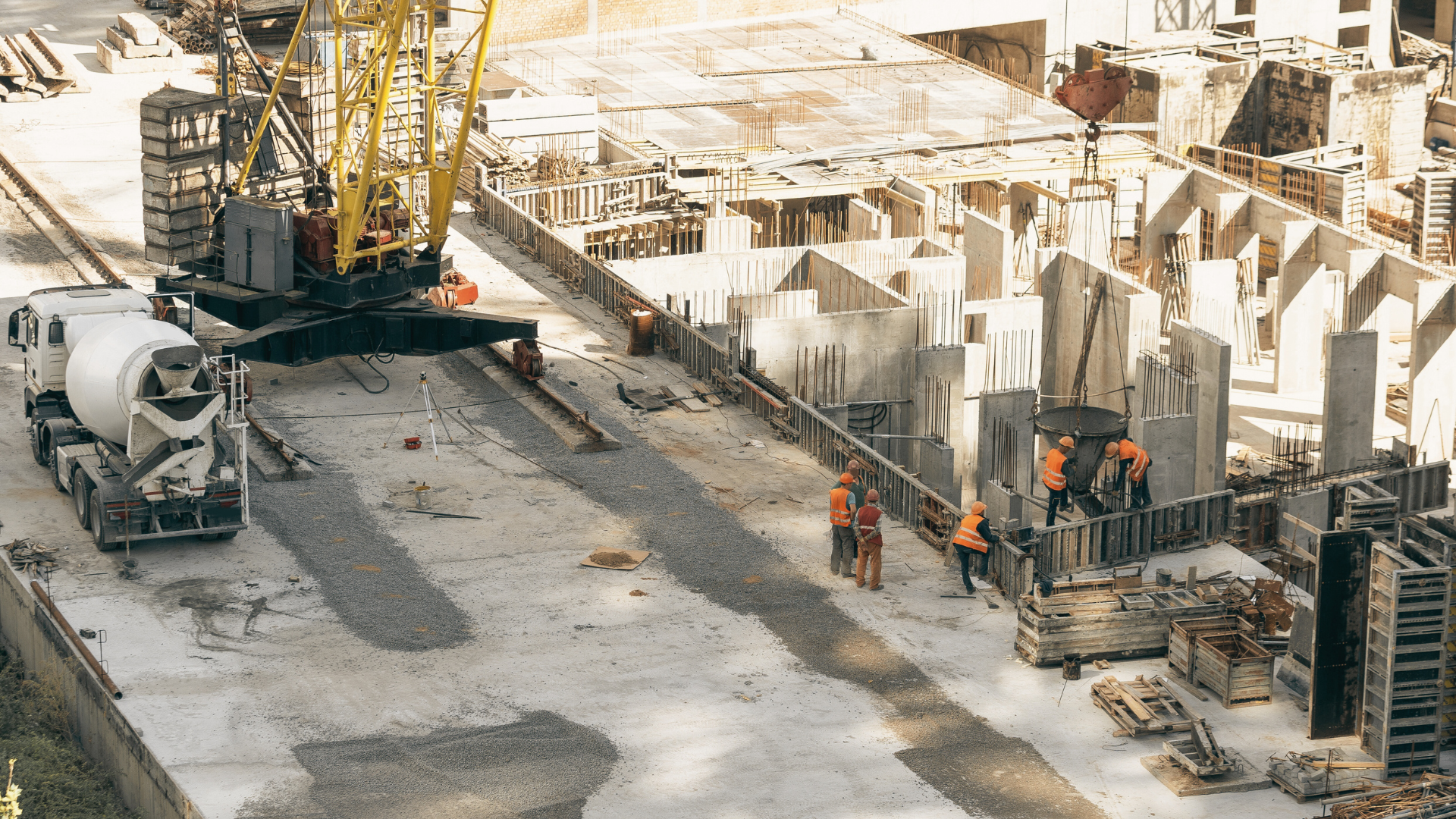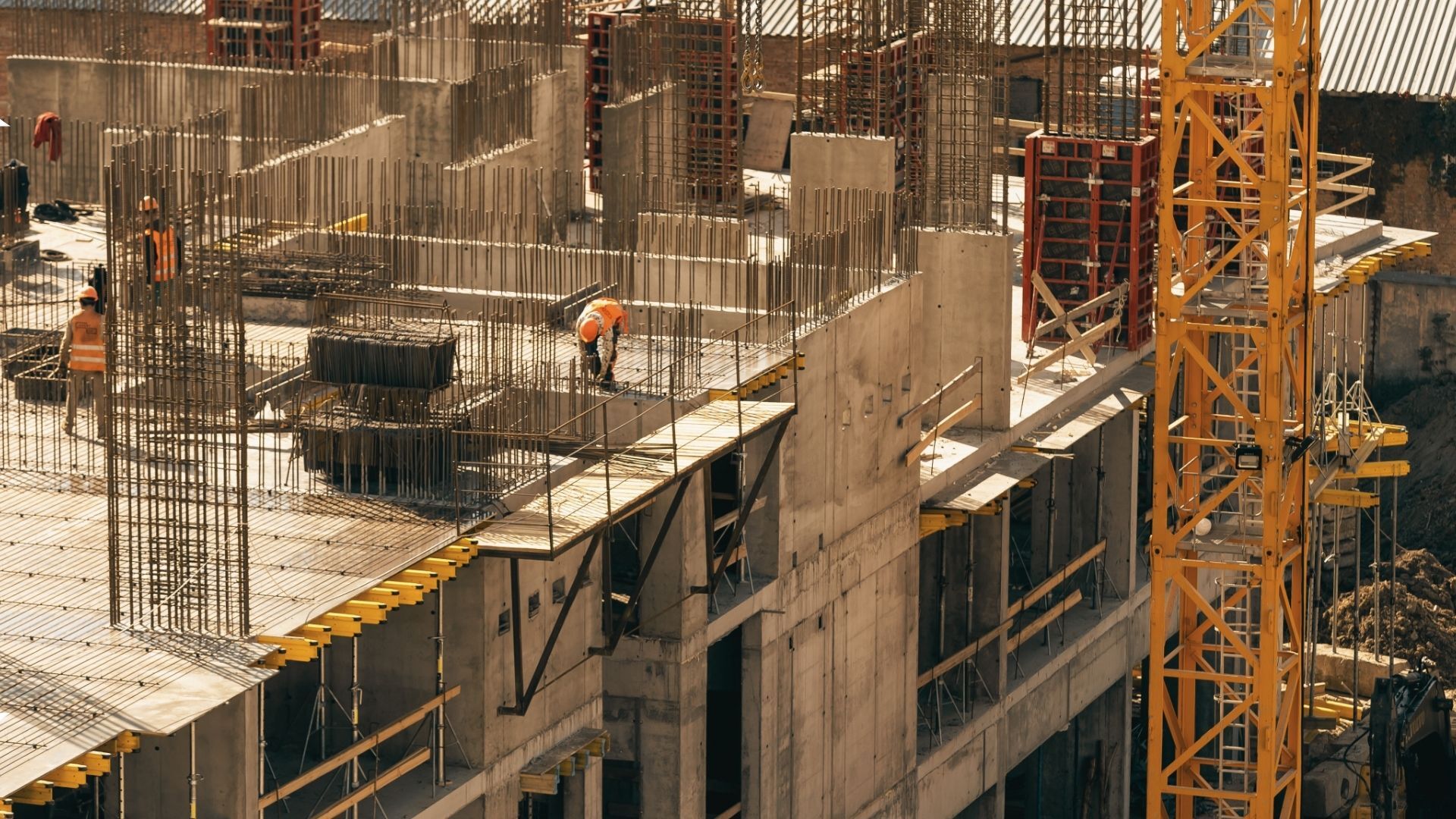Productivity Crisis Meets Regulatory Push as NSW Grapples with Housing Targets
This edition of The Pulse examines a NSW construction sector at a critical juncture, caught between aggressive government housing supply initiatives and deep-seated structural challenges.
Overview
The Minns Government is actively fast-tracking thousands of homes through State Significant Development declarations and enabling ‘missing middle’ housing reforms [1, 11, 13]. However, these ambitions are colliding with stark realities: CEDA reports reveal productivity has stagnated for decades, hampered by an industry dominated by small firms [17, 18]. This inefficiency is compounded by soaring building costs and regulatory burdens, which account for up to 50% of a new dwelling's cost [5]. Simultaneously, the Building Commission NSW is intensifying its compliance crackdown in regional areas, issuing a wave of rectification orders and fines for defects and unlicensed work [2, 16]. This heightened scrutiny, coupled with major contractual disputes like the M6 motorway contractor exit, underscores a high-risk environment where understanding contractual obligations and maintaining compliance is paramount for survival and success [14].
Government's Dual Strategy on Housing Supply Faces Headwinds
The NSW Government is pursuing an aggressive, two-pronged strategy to address the housing crisis, though its efforts are being tested by significant market and structural impediments. Firstly, the government is leveraging the Housing Delivery Authority (HDA) to fast-track large-scale developments [1, 11]. Since its inception in December 2024, the HDA has recommended 116 proposals be declared State Significant Development (SSD), representing over 45,200 potential homes that can bypass traditional council approval processes [1, 11]. Recent declarations include over 5,200 homes across 14 projects in metropolitan Sydney and regional NSW [1]. Secondly, the state is promoting density in established suburbs through policies, implemented in February 2025, that remove restrictions on low- and mid-rise "missing middle" housing around transport hubs and town centres [13].
Despite these top-down initiatives, the state is struggling to meet its targets. A national report indicates NSW is on track to achieve only 65% of its Housing Accord goal, with the national target of 1.2 million homes also projected to be missed significantly [10]. The core challenges are systemic. The residential construction industry's productivity is reportedly half what it was 30 years ago, largely due to bureaucracy [5]. Furthermore, CEDA reports highlight that the sector's structure, with 98.5% of firms employing fewer than 20 people, stifles innovation and economies of scale [17, 18]. These productivity issues are exacerbated by high costs, with government fees, taxes, and charges comprising 40-50% of a new dwelling's price in cities like Sydney [5]. The failure of a proposed "mega housing metropolis" in western Sydney following a "controversial vote" further illustrates the political and community-level risks that can derail even bold government-backed projects [7].
Regulatory Scrutiny and Compliance Pressure Intensifies
The Building Commission NSW is escalating its enforcement activities across the state, with a particular focus on regional areas, signalling that non-compliance will be met with significant penalties. Recent inspection blitzes in the Riverina-Murray region, including Albury, Corowa, and Howlong, have uncovered widespread issues, putting builders on notice [2, 16]. In one campaign, inspections of 41 new build sites led to the expected issuance of 29 rectification orders [16]. In a similar blitz covering 29 sites in the Albury and Riverina Murray regions, 18 rectification orders were flagged and 13 fines totalling $16,490 were imposed [2].
The breaches identified are fundamental, ranging from unlicensed contracting and improper signage to specific construction defects [2, 16]. A commonly cited and critical defect is the improper installation of damp proof course, which the Commission is targeting with strong action to prevent moisture-related issues like mould [2]. The fines are not limited to minor infractions; they address serious regulatory offences such as non-regulation electrical work and engaging in construction without the appropriate licenses [2, 16]. This crackdown is not a one-off event but part of a sustained compliance campaign that began in early 2025 [16]. The Commission has also vowed to conduct follow-up inspections to ensure all mandated rectifications are completed, reinforcing a zero-tolerance approach [2]. This heightened scrutiny places a significant onus on developers and principal contractors to implement rigorous quality assurance and perform thorough due diligence on all subcontractors to avoid costly rectification work, financial penalties, and reputational damage.
Productivity and Market Structure Under the Microscope
A critical challenge undermining the industry's capacity to meet housing demand is its stagnant productivity, an issue CEDA has linked directly to the sector's fragmented structure [17, 18]. Reports indicate that construction productivity has barely moved since the mid-1990s, while Australia now builds half as many homes per construction worker as it did in the 1970s [18]. This inefficiency is a major barrier to achieving the government's housing targets, especially in Sydney, now ranked the world's second most expensive housing market [17, 18]. The core of the problem, according to CEDA, is the dominance of small firms: 98.5% of construction companies have fewer than 20 employees, and 91% are microbusinesses with fewer than five [17].
This structure has profound commercial consequences. Larger firms with over 200 employees are shown to be significantly more productive, generating 86% more revenue per worker than firms with 5 to 19 employees [17, 18]. CEDA estimates that if the industry's firm sizes mirrored those in manufacturing, it could generate an additional $52-54 billion in annual revenue without more workers [17, 18]. Factors contributing to this fragmentation include tax settings that favour smaller businesses, complex and decentralised state-based regulations, and occupational licensing rules that act as barriers to expansion [17, 18]. This structural weakness is compounded by a national housing supply deficit of over 250,000 homes and a labour force challenge, where recent migration patterns have increased housing demand more than they have boosted the construction trade workforce [6, 10].
Contractual Risk and Market Realities
A high-profile dispute on the $3.1 billion M6 Stage One motorway project has cast a harsh light on contractual risk allocation in major NSW infrastructure projects [14]. The joint venture contractor, CGU, announced its withdrawal from the project, claiming the contract was "frustrated" by unforeseen adverse ground conditions [14]. However, Premier Chris Minns publicly rejected this claim, stating the "design and construct" contract placed full responsibility for such risks squarely on the contractor. The Premier’s firm stance that the government "won't be put over a barrel" or issue a "blank cheque" serves as a stark warning to the industry about the government's unwillingness to absorb costs for risks contractually assigned to contractors [14].
This major project dispute unfolds against a mixed economic backdrop. On one hand, recent interest rate cuts have spurred a 40% spike in home auction volumes and boosted buyer confidence, with new home sales hitting a 12-month high [4]. There is also optimism regarding the stability of material supply chains, with high demand for iron ore expected to continue despite global trade tensions [12]. On the other hand, the market is shaped by affordability pressures. High construction costs are a primary concern for 71% of industry professionals and are actively deterring buyers from purchasing unrenovated properties [5, 9]. A CBRE survey shows strong demand for new or recently renovated homes, as buyers are unwilling to bear the cost and risk of major upgrades themselves [9]. This dynamic, coupled with the ever-present risk of project feasibility challenges due to high costs and red tape, creates a complex commercial environment where robust contract management is critical [5, 10].
Takeaways
Design & Construct Contracts: The Unforeseen is Foreseeable
The dispute over the M6 motorway project serves as a critical reminder of the risk allocation inherent in Design and Construct (D&C) contracts [14]. The contractor's claim of "frustration" due to unforeseen ground conditions was publicly refuted by the NSW Premier, who emphasised that a D&C model contractually obligates the contractor to manage such risks [14]. For builders and contractors, this reinforces that courts are often reluctant to find a contract frustrated, especially where the contract's terms have already allocated risk for the event in question. Relying on "unforeseen" conditions as a basis to exit a contract is exceptionally difficult. Practical Guidance: Before entering D&C contracts, contractors must conduct exhaustive due diligence, including geotechnical investigations, and ensure tender prices adequately reflect the full spectrum of risks being assumed. Any ambiguity in risk allocation clauses should be clarified and negotiated, as the government's stance indicates it will strictly enforce the contract's terms.
Navigating New Planning Pathways and Compliance
The government's push to accelerate housing supply via State Significant Development (SSD) declarations and "missing middle" housing reforms creates both opportunities and legal complexities [1, 11, 13]. The SSD pathway, governed by the Environmental Planning and Assessment Act 1979, allows the state to bypass local council approvals, centralising the assessment process [1]. This can significantly reduce approval timelines but requires developers to engage directly with state-level bodies like the Housing Delivery Authority (HDA). Similarly, the February 2025 policy changes allowing medium-density housing near transport hubs open up new development avenues [13]. Practical Guidance: Developers should proactively assess if their projects, particularly those with affordable housing components, meet the criteria for SSD status and engage with the HDA early. For "missing middle" projects, it is crucial to understand the specific new planning controls and design guides that apply to these rezoned areas to ensure compliance and streamline approvals.
Compliance is Non-Negotiable: The Building Commission's Broad Reach
The intensified compliance blitzes by Building Commission NSW in regional areas demonstrate a clear regulatory mandate to enforce standards across the entire state [2, 16]. The issuance of numerous rectification orders and fines for unlicensed work, non-compliant electrical work, and defects like faulty damp proofing highlights the Commission's focus on fundamental aspects of the Home Building Act 1989 and associated regulations [2]. The threat is not just financial; a public rectification order can cause significant reputational damage and impact a builder's ability to secure future work and insurance. Practical Guidance: All builders and contractors must embed a culture of compliance. This includes rigorous verification of all subcontractor licenses, implementing multi-stage quality assurance checks to identify and fix defects before completion, and ensuring all site and administrative requirements, such as signage, are met. Assuming regional projects are subject to less scrutiny is a costly mistake.
Final Thoughts
The NSW construction industry is navigating a period of intense pressure and transformation. While government initiatives to fast-track housing supply present significant opportunities, they are set against a backdrop of systemic productivity challenges, rising costs, and heightened regulatory enforcement. The clear message from the state is twofold: it will facilitate development through streamlined planning but will not tolerate poor quality or attempts to shift contractual risk. For professionals, the path forward requires a dual focus on operational excellence and strategic foresight. Firms that can innovate to improve productivity, maintain impeccable compliance standards, and manage contractual risks with diligence will be best positioned to thrive. Those that fail to adapt to this new paradigm of heightened expectations and scrutiny face significant financial and reputational peril.
[1]. Paul Scully | 27 May 2025, 11:14am AEST. (27 May 2025). More than 5,200 homes declared state significant. https://paulscullymp.com.au/news/media-releases/more-than-5-200-homes-declared-state-significant/
[2]. The Border Mail | by Saffron Howden 27 May 2025, 5:00am AEST. (27 May 2025). Builders put on notice after inspection blitz finds shoddy construction work. https://www.bordermail.com.au/story/8976024/albury-builders-face-fines-after-inspection-finds-shoddy-construction/
[3]. Architecture and Design | by View Author 26 May 2025, 3:10pm AEST. (26 May 2025). Shaping tomorrow at the Sustainability Summit 2025. https://www.architectureanddesign.com.au/editorial/industry-news/shaping-tomorrow-at-the-sustainability-summit-2025
[4]. by Jacob Shteyman 26 May 2025, 2:26pm AEST. (26 May 2025). Rate cut hammers in immediate spike in home auctions. https://thewest.com.au/news/urban-planning/rate-cut-hammers-in-immediate-spike-in-home-auctions-c-18818149?utm_source=csp&utm_medium=portal&utm_campaign=Streem&token=ps5kmduLkiKNNj2HqhvS7E%2BYGVcBzZ5mbNRLhbGlTG7b%2BzGv9Fjj0vKUdHbVdH4vrzWuIlnmWR7gFE4Rrtb%2Bgw%3D%3D
[5]. by Terry Ryder 26 May 2025, 2:17pm AEST. (26 May 2025). Building costs, not interest rates, are killing housing affordability. https://tickernews.co/building-costs-not-interest-rates-are-killing-housing-affordability/
[6]. by Tarric Brooker. (None). Truth about the big tradie move that could change Australia forever. https://www.ntnews.com.au/business/work/at-work/truth-about-the-big-tradie-move-that-could-change-australia-forever/news-story/47b909d9320d825d38895a0c10992549?btr=ae5c7f357b54d9e818f2c4a152c7e2bf
[7]. The Daily Mail | by Australian Associated 28 May 2025, 1:45pm AEST. (28 May 2025). Premier defends bold housing bet after racecourse fail. https://www.dailymail.co.uk/wires/aap/article-14755873/Premier-defends-bold-housing-bet-racecourse-fail.html
[8]. SBS News | 25 May 2025, 5:35pm AEST. (25 May 2025). Nationals play down speculation of a leadership spill after Coalition breakup. https://www.sbs.com.au/news/podcast-episode/nationals-play-down-speculation-of-a-leadership-spill-after-coalition-breakup/18yys7bsi
[9]. The ASEAN Developer | 23 May 2025, 12:23pm AEST. (23 May 2025). New and renovated properties in high demand across Australia - CBRE. https://www.theaseandeveloper.com/news/2025/05/23/new-and-renovated-properties-high-demand-across-australia-cbre/1747965436
[10]. Real Estate | by Jonathan Chancellor 23 May 2025, 5:30am AEST. (23 May 2025). Australia’s housing crisis ‘decades in the making’. https://www.realestate.com.au/news/australias-housing-crisis-decades-in-the-making/?cspt=1750982987|bc38fc4134051d2cec8e58b3649597c7
[11]. St George & Sutherland Shire Leader | by Murray Trembath 28 May 2025, 1:19pm AEST. (28 May 2025). Fast-tracked housing: Caringbah site declared state Significant Development. https://www.theleader.com.au/story/8963895/caringbah-site-becomes-state-significant-project/
[12]. The Daily Mail | by Australian Associated 22 May 2025, 6:40pm AEST. (22 May 2025). Australian firms 'upbeat' China can navigate trade war. https://www.dailymail.co.uk/wires/aap/article-14738527/Australian-firms-upbeat-China-navigate-trade-war.html
[13]. Real Estate Business | by Sebastian Holloman 22 May 2025, 4:14pm AEST. (22 May 2025). ACT reforms to support more ‘missing middle’ housing. https://www.realestatebusiness.com.au/industry/29935-act-reforms-to-support-more-missing-middle-housing
[14]. St George & Sutherland Shire Leader | by Murray Trembath 22 May 2025, 11:38am AEST. (22 May 2025). 'We won't be put over a barrel': Minns responds to exit of M6 contractor. https://www.theleader.com.au/story/8973192/m6-motorway-woes-nsw-seeks-solutions-after-contractor-exit/
[15]. by Zoe Cartwright 22 May 2025, 5:18am AEST. (22 May 2025). Port Kembla residents welcome active transport upgrades. https://regionillawarra.com.au/port-kembla-residents-welcome-active-transport-upgrades/60022/
[16]. Kyabram Free Press | by Yarrawonga Chronicle 28 May 2025, 6:00am AEST. (28 May 2025). Building compliance crackdown. https://www.kyfreepress.com.au/news/building-compliance-crackdown/
[17]. Accounting Times | by Emma Partis 28 May 2025, 5:00am AEST. (28 May 2025). Dominance of small construction firms drags down productivity, CEDA says. https://www.accountingtimes.com.au/economy/dominance-of-small-construction-firms-drags-down-productivity-ceda-says
[18]. Committee of Economic Development in Australia | 27 May 2025, 4:15pm AEST. (27 May 2025). Size matters: Why construction productivity is so weak. https://www.ceda.com.au/newsandresources/mediareleases/workforce-skills/size-matters-why-construction-productivity-is-so-weak
The Pulse collates the latest news and opinions from third-party sources. Links, snippets or text are generated by an artificial intelligence engine. The Pulse aggregates news reports and does not claim to have copyright to the content. We have not fact-checked that content and cannot vouch for its accuracy or completeness. Nor do we endorse the opinions expressed by the authors or primary publishers. The content is provided as general information only and should not be relied on as a substitute for professional advice. You should contact the source to verify any factual content as well as taking specialist advice that takes your personal objectives and circumstances into account.




.png)


.jpg)








.jpg)




